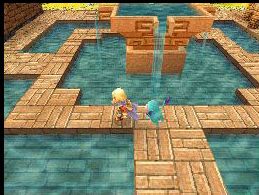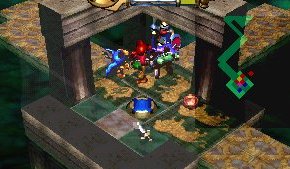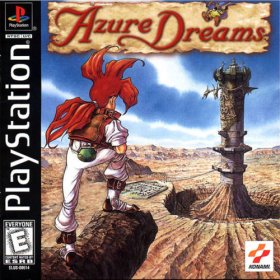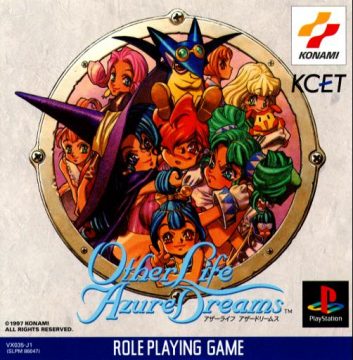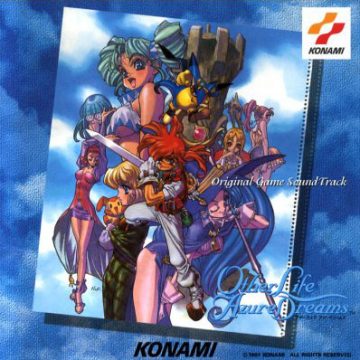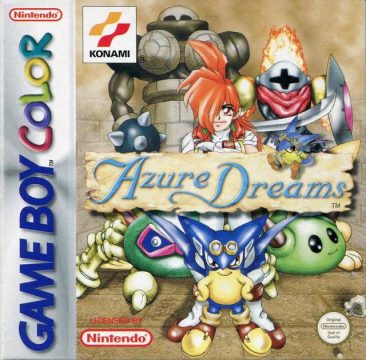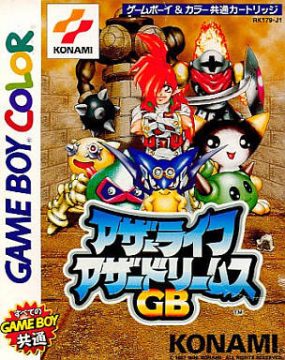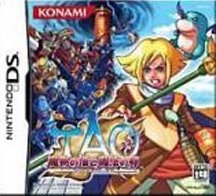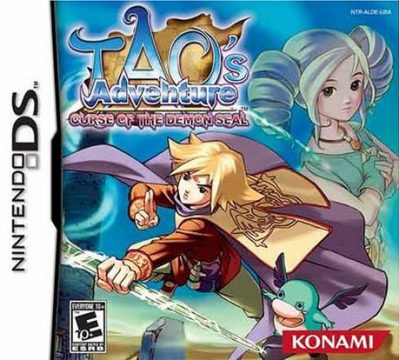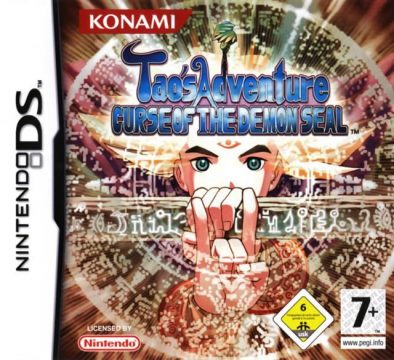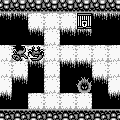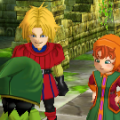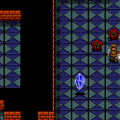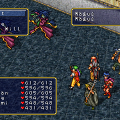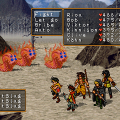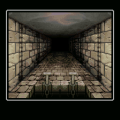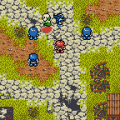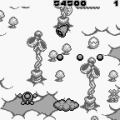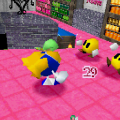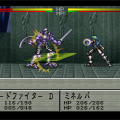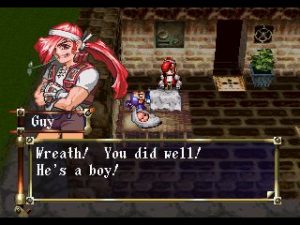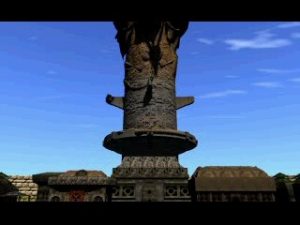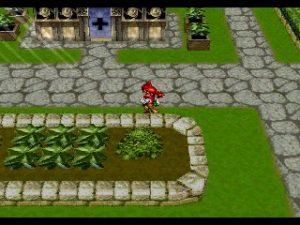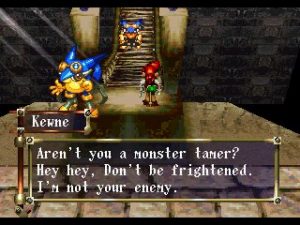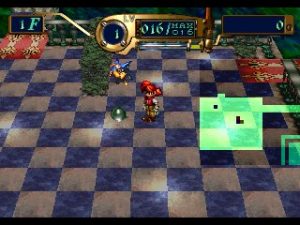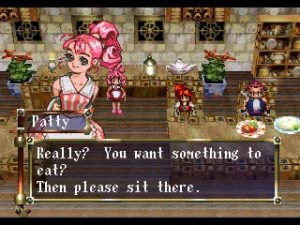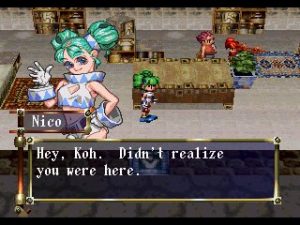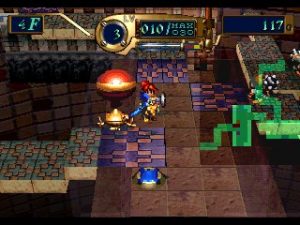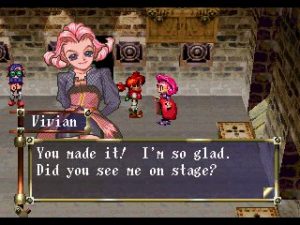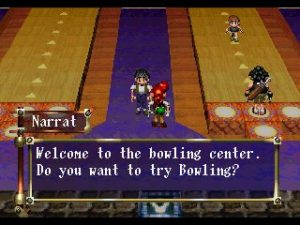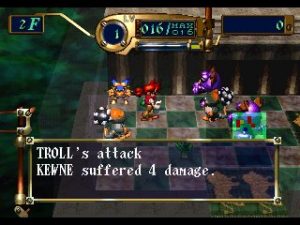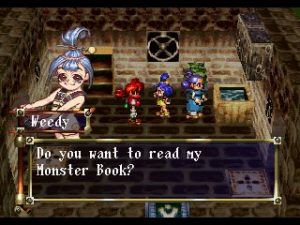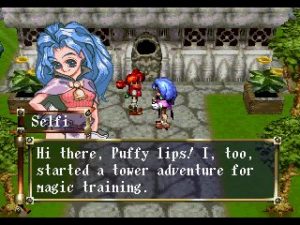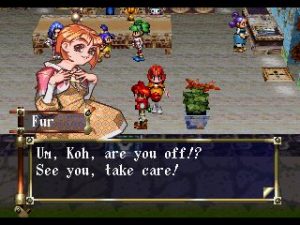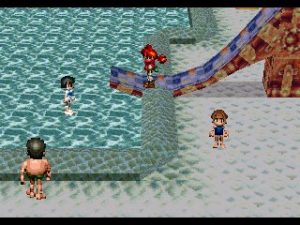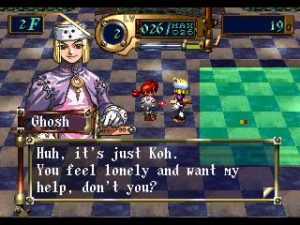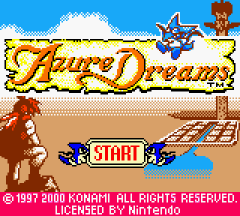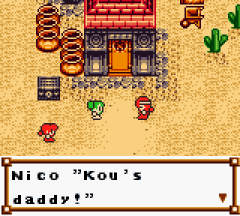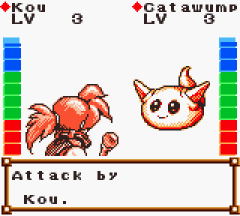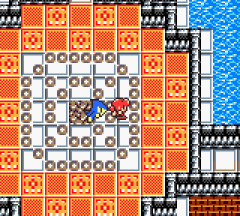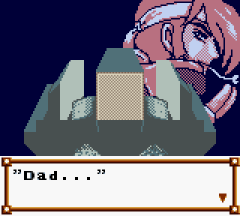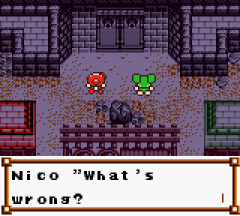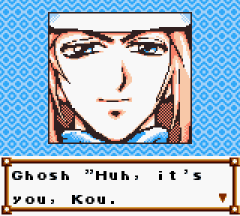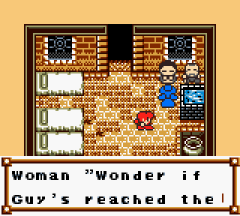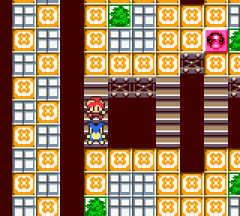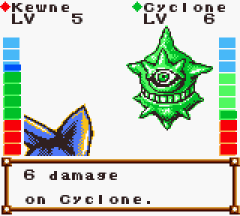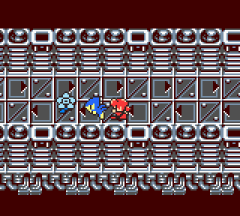Not everyone likes dungeon crawlers. Some are put off by the tedious gameplay. Others lament the lack of story or character development. Others are put off by the claustrophobic feeling of only having a single town or single dungeon. Add into that randomly-generated dungeons and many people simply won’t touch the genre. Konami’s Azure Dreams takes the basic approach taken by rogue-likes like the Mystery Dungeon games, while combining elements from other games so it’s not so focused on just one activity. It may not have all of the stat-management and equipment lists of other dungeon crawlers, but it’s an easy game to pick up and play.
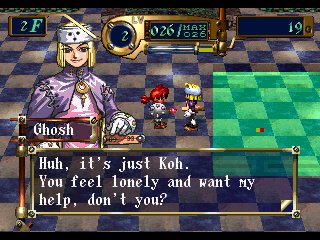
Azure Dreams takes place in the desert town of Monsbaiya. A remote frontier town, its located next to the Monster Tower, a mysterious structure brimming with both fantastic treasure and vicious monsters. Fortune-seekers from all over come to Monsbaiya in the hopes of striking it rich by collecting Monster Eggs from the tower and selling them for big cash. You play as Koh, a boy living in Monsbaiya, who has slightly more noble desires – he simply wants to help is struggling family.
Most of the action takes place in the Monster Tower, but what sets Azure Dreams apart from the standard Mystery Dungeon-type gameplay are all of the things you can do in town, like build new houses or win over the numerous girls that live in town (shades of Konami’s own Tokimeki Memorial). These dating and simulation elements add a significant layer of depth to the dungeon crawling.
Characters
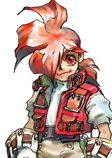
Koh
The guy you’ll be playing as. He’s just turned 15 and wants to follow in his father’s footsteps to become an adventurer. Mostly a silent protagonist, he’ll talk occasionally when you select dialog choices when talking to NPCs.
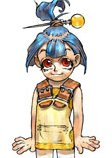
Weedy
Our hero’s little sister. She carries around a monster book that gets filled every time you encounter new monsters in the Tower. She’ll also wake you up in the morning if you haven’t wooed any girls.
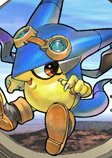
Kewne
A talking monster you meet right before entering the Tower, he’ll become your first familiar. Although he’s the only one of his kind, you can swap him out when you get new monsters.
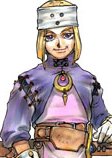
Ghose Rode
A member of the wealthy Rode family, he’s an arrogant jerk that likes to start fights with Koh. You’ll have plenty of opportunities to humiliate him throughout the game. In the Tower you can sometimes duel him, but nothing comes of it, win or lose.
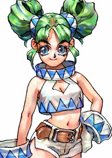
Nico Southley
Koh’s childhood friend and resident tomboy. She respected Guy a lot and wants to make Monsbaiya a more cultured place.
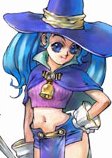
Selfi Rode
Ghosh’s younger sister, she wants to become a sorceress. A bit vapid-minded, she’ll call you stupid nicknames until you win her over.
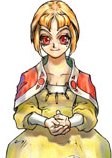
Fur Gots
She runs the general store, where you can buy items for your house or presents for girls. She likes money and will tease you for being poor.
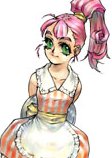
Patty Pan
A waitress at the restaurant. Because of your lack of cash, she’s wary that you’ll dine and dash (an option you can do, actually).
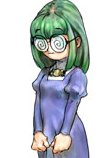
Mia Myria
A shy, book worm loli with goofy glasses. At first she’ll run away from you, but then she’ll become your stalker! Very creepy, considering she’s 13. When she doesn’t have her glasses on, she looks a lot different.
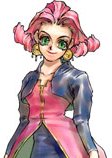
Vivian Merca
A woman who comes from a different town. She’s a performer struggling to become a dancer.
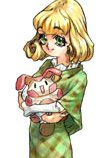
Cherral Child
A sickly girl who spends much of her time inside and is rather clingy. The cure to her sickness lies in the Monster Tower.
If you’re familiar with any of Chunsoft’s Mystery Dungeon games (a few were released in America, including Square’s Chocobo’s Mysterious Dungeon 2 and Torneko: The Last Hope), you’ll be quite at home with Azure Dreams, because it’s essentially a rogue-like. The majority of the game will be spent in the Monster Tower. Once inside, your goal is simple: get to the top. All you have to do is find the elevator on the floor, while collecting items and fighting the other monsters you encounter on your way. Each floor is randomly generated, although a few are constant. All the action is semi-real time – for every move you make, the enemy makes one move as well.
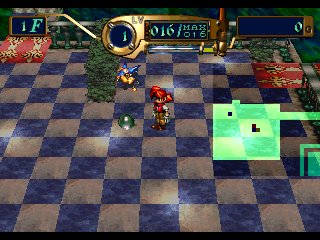
You can take up to five items when entering, although your familiar counts as an item. Your familiars will be controlled by the AI, but you can change their attack settings or control then directly if you want. It makes the game move pretty quickly, as there’s no random encounters and you can clearly see enemies as they approach. You also have an auto-map in the corner of your screen, and you can full-size it and continue to walk around at the same time.
A special note should be made of the traps in the game. While some are harmless, there are times when a trap can completely ruin your day. Some of the more malicious ones are Go Up, which sends you to the next floor. Not bad, unless your familiar steps on it and you’re about to fight a tough monster. Chaos, which muddles your familiar and makes him attack you, and Monster Den, where suddenly monsters flood the room you’re in. All traps are invisible until you either use an item that shows where they are, or walk over them. They definitely add a bit of suspense to the game and keep you on your toes.
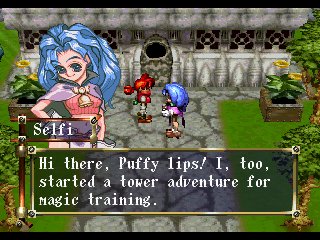
Every time you leave the Tower, Koh drops back down to level one. However, your familiar retains whatever level it was at before you left. So basically you’ll be tackling the Tower bit by bit, leveling your familiar and pushing up as high as you can, then exiting. Later on, you’ll find a collar that allows you two control two familiars, either simultaneously or one at a time. But there is a catch – your familiar’s MP will slowly decrease over time, which you need to restore with items like a Pita Fruit or herbs. If their MP hits zero, they’ll become immobile. Fortunately, if they die, you won’t lose them permanently. However, if Koh dies, it’s a completely different story. You’ll lose all of the items in your inventory (except for familiars and their levels) and end up back home. It’s not a “Game Over”, but it’ll penalize you. The only way to safely leave the Tower is with the Wind Crystal, but you’ll have to find one first. Like all items, their appearances are randomly generated, so you can really only leave the Tower when the game decides to let you.
Koh himself is somewhat helpless. Due to the fact that his level resets, you’ll rely a lot on your familiars. He can equip a wand or a sword, as well as a shield, which can be strengthened with rare items, but he won’t do much damage himself. Most of the time, you’ll be supporting your familiar by healing it, using spell-casting items, or simply throwing crappy items at the enemy for small amounts of damage. There’s quite a few items, such as orbs that cast magic, scrolls and bells that do a variety of effects, and seeds to strengthen/weaken monsters. It gets pretty interesting if you have a variety of items, because it’s possible for you to take down some strong enemies with some clever thinking.
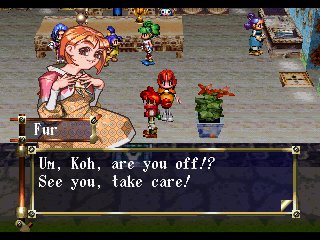
Other than training your familiar, the second most important goal is finding more Monster Eggs. You can hatch them inside the tower for a temporary ally, but can’t take them back with you. If you do bring them home, you can then sell the egg for cash, or keep it, either to have a second familiar to build up, or to fuse it with another of your familiars. Monsters come in with wind/water/fire attributes, with a rocks/paper/scissors effect triangle. Fusing them can change the element of the monster, give it special abilities, new magic, and more strength. However, fusing two monsters just change stats around and won’t create any unique monsters doing this, unlike the Megami Tensei games. While not required, it can make the game easier by fusing monsters to get desired traits and magic. Also, some monsters evolve after hitting a specific level.
When you’re not questing in the Monster Tower, you can attempt to earn the affections of any of the girls around town, each of which is won through a different method. The goal is to pimp it up and get all of the ladies to like you, so there’s no fear to jilting one in favor of another. Some, like Nico and Selfi are rather easy to woo, but other girls like Vivian and Cherral are a little more difficult. They’re fun subquests, but you don’t really get anything much out of it. With your money you can also build new buildings or make some improvements to existing ones. You can expand your monster hut to allow for more monster storage, or simply construct a bigger house for your family. However, most of the others, like the gym, arcade, and pool are just crappy minigames. A neat touch is that as you progress through the Tower and build more buildings, people’s attitudes towards you (except Ghosh’s) will become more respectful.
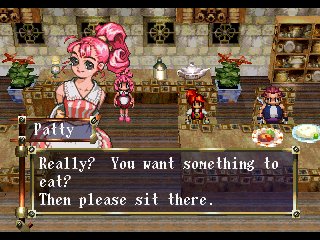
Graphically, the game isn’t so hot. The floors inside the Tower itself are a bunch of rooms hanging in space connected by pathways, with different textures slapped on every few floors or so. The character models look like someone took a 3D model and slapped pixelized paint all over them – not so pretty. The artwork itself is very nice, and when you talk to NPCs such as the various girls they have a character portrait with small animations (well, blinking eyes, really). They also have multiple pictures which change depending on their relationship with you. The music is also unremarkable. Each girl has their own theme but unless you sit next to them, it’ll be brief. The Tower and town music, while nothing terrible, is forgettable and will just be in the back of your head as you play.
The Japanese and American games are pretty much identical outside of language. There were several rumors regarding Azure Dreams that have been floating around for years upon years – just to confirm, you can’t marry any of the girls in the Japanese version, and you can’t get Ghosh as a boyfriend. The marriage rumor is understandable, as the description of the ring in Fur’s shop implies that you can propose, but you can’t. As for Ghosh, when you go to the save screen, along the bottom the head of each girl that you’ve successfully wooed appears. The rumor was Ghosh was the last spot rather than Kewne, but he’s not. The only difference is that the girls in the Japanese version have spoken audio voices. Otherwise, it’s the same game.
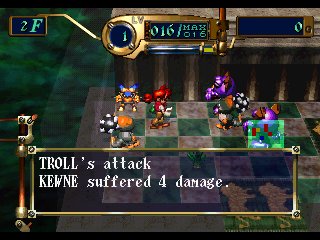
When you come down to it, Azure Dreams is like many of the other dungeon crawlers out there, with a few new additions. While it’s nice to get the girls and build new places, nothing really comes of it. In fact, many of the buildings you make will only be to unlock the various girls. It would have really been a cool feature if maybe getting a girl would give you a bonus, or even if you could bring one into the Tower and assign them their own familiar. Still, it’s something fun to do other than grind in the Tower. The music and graphics don’t really stand out, and the plot is rather tame (although refreshingly low-key and drama free) but the game is good at what it does. While it can be difficult if you go for a long stretch without finding a Wind Crystal, if you like these types of games, then it’s worth checking out. If you don’t already, this probably won’t convince you otherwise.
Azure Dreams / Other Life: Azure Dreams GB (アザーライフ アザードリームス GB) – Game Boy Color (1999)
Azure Dreams for the PlayStation wasn’t exactly a hot seller, but Konami decided to port it to the Game Boy Color, possibly to cash-in on the Pokémon craze. While still having the same premise and plot as Azure Dreams, the downsized version has a number of changes.
The graphics are now all 2D, obviously, with all the characters turned into squat little blobs. The art style for the characters is a bit different also. There’s now a total of 116 monsters (called “Tameons” here) to collect rather than the 50 from the PlayStation game. Also, there is the option to exchange monsters with a friend which furthers the Pokémon connection. The plot is a bit involving, as you’ll meet some of Guy’s old companions, who will chat a bit and give you items. You’ll also fight a stronger Ghosh in the upper levels, as well as a few boss battles. After beating the game, you unlock a 99 floor dungeon that hides a second ending. The music and sounds have been reproduced pretty faithfully, but still aren’t amazing or really catchy.
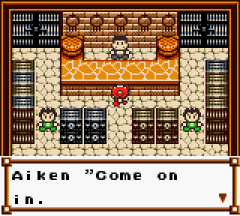
Unfortunately, a lot of aspects have been dumbed down or cut entirely. The relationship building aspects of the PlayStation game have been ditched. Because of this, Vivian, Cherral, Mia, and Patty are nowhere to be found. Fur is still here, but she no longer gets a character portrait. Also gone is all of the town construction elements. You can only upgrade your house and monster hut, and you can donate money to Nico in order to beautify Monsbaiya, but you can no longer build and place individual buildings. While both features were mostly useless, they were fun things to do outside of the Tower and you miss them when they’re gone.

Kou
Same as before, but spelled differently this time. He’s also a bit more talkative.

Weedy
She’s still your sister, and still has the monster book.

Ghosh
Still a jerk, but you fight him more often and he becomes more challenging.

Nico
Ever the tomboy and Kou’s childhood friend. You can donate money to her to clean up Monsbaiya.

Selfi
Same as before, still calls you stupid nicknames.

Attley
A warrior woman who was a former acquaintance of Guy’s, you’ll bump into her and Guy’s other friends randomly. She gives you Wind Gems (Wind Crystals).

Skale
A thief and treasure hunter, he’ll give you Vit Seeds (Pita Fruits).

Marzin
A crazy looking old conjurer, he’ll heal you and your monster.
Some claim that the game mechanics in the GBC version are better than the PlayStation version, but that’s debatable. Sure, the monsters aren’t nearly as aggressive, nor do they do as much damage, so it’s not as immediately intimidating. And monster fusing is also a bit more in-depth. However, combat is even clunkier, since you can no longer move or attack diagonally. It’s hard to see Koh’s attacks, and the view occasionally changes into a Pokémon-style combat view, which slows down the pacing. There’s still a map, but you have to go through the menu to get it, slowing the game down as its fairly easy to get lost. Items are far more plentiful, and for no reason whatsoever, all the items and spells were renamed, despite the translation otherwise being pretty similar to the PlayStation game.
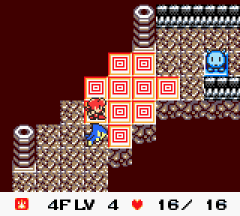
Overall, the GBC version is a bit of a letdown. The two features that made the first game feel unique were taken out with some of the characters, the game feels much slower than before, and the whole ordeal is just a bit too easy.
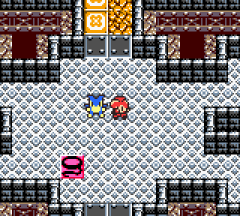
Tao’s Adventure: Curse of the Demon Seal / Tao: The Goblin’s Tower and the Magical Egg (TAO魔物の塔と魔法卵) – Nintendo DS (2005)
Tao’s Adventure is a semi-sequel that follows Azure Dreams‘ basic premise. You play as Tao who has the ability to “air cast”, which is a method of casting magic spells. (You see, Tao’s Adventure‘s big innovation was using the stylus to draw runes on the touch screen to cast spells.) Anyway, Tao is sent from his home island of Bente to the town of Mondominio in order to get a rare monster egg from the Tower. The Tower’s seal has been broken, however, and all the villagers are turned to stone. A talking monster named Petcho forces his way into the party and the two go off to break the curse.
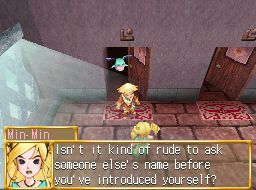
The game received universally horrible reviews. Citing loading times between menus, the majority of the game being used by the touch screen and slow pacing, it seems like all the bad things from Other Life were brought over to Tao’s Adventure. You can still find eggs and raise new monster familiars, which can be brought to a coliseum to fight, but there’s none of the town building or dating sim aspects. So while there are a number of similarities to Azure Dreams, Tao’s Adventure should be regarded as a subpar as a spin-off game and avoided.
